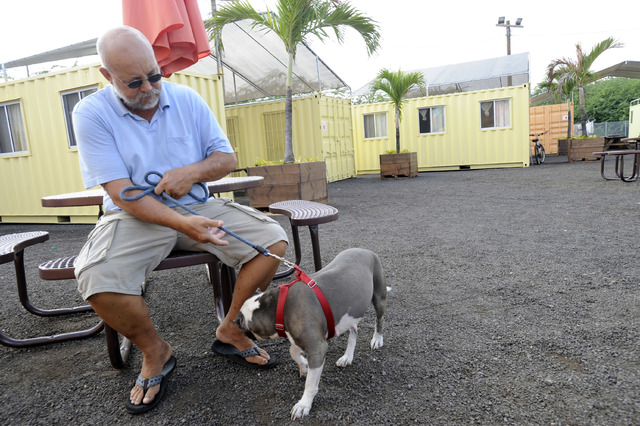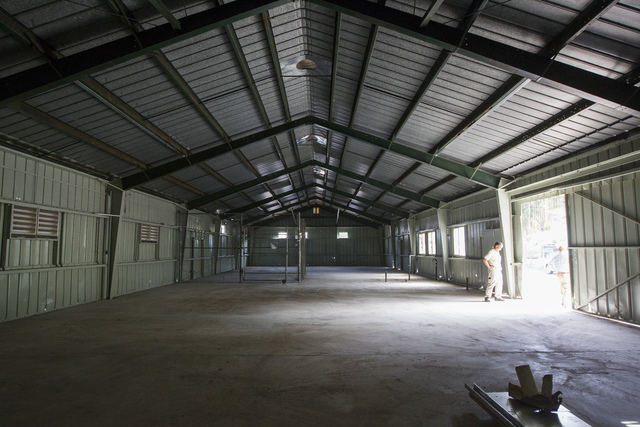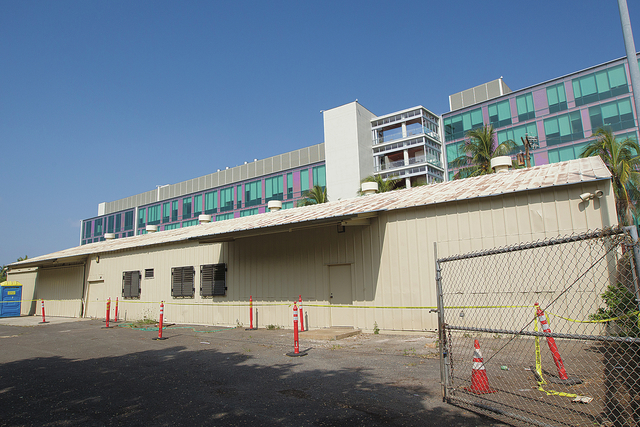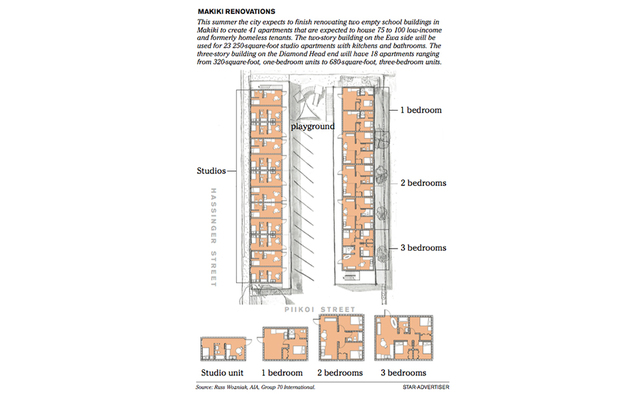Efforts pave way for wider options

BRUCE ASATO / BASATO@STARADVERTISER.COM
Neal Blau Sr. sits at a table with his pit bull Mele at the Hale Mauliola homeless shelter at Sand Island. Blau used to live on the street and in his vehicle.

KRYSTLE MARCELLUS / KMARCELLUS@STARADVERTISER.COM
The state’s homeless coordinator, Scott Morishige, estimates the maintenance shed in Kakaako could shelter as many as 240 people a year.

KRYSTLE MARCELLUS / KMARCELLUS@STARADVERTISER.COM
The state is planning to use this 5,000-square-foot building in Kakaako to house as many as 60 people at a time.





LAST OF TWO PARTS
———
In the coming months Oahu will see a new homeless shelter in Kakaako; the first-of-its kind, city-owned apartment building in Makiki for low-income and formerly homeless tenants; and greater efforts to help homeless Micronesians and get churches more involved.
The new initiatives are part of a bigger push by the city and state this year to get more homeless people off the streets and into homes.
Mayor Kirk Caldwell is considering any option, including the possibility of partnering with a potential developer to build a high-rise in the urban core that wouldn’t ban tenants who drink or use drugs.
There are no specific plans for such a high-rise devoted to helping the homeless, but Caldwell said he is open to any new ideas to reduce homelessness as the city grapples with the highest per-capita homeless population in the country.
Don't miss out on what's happening!
Stay in touch with breaking news, as it happens, conveniently in your email inbox. It's FREE!
“Everything’s on the table,” Caldwell told the Honolulu Star-Advertiser last week.
Like Seattle, another tourist-friendly city with plenty of homeless people, Caldwell is also willing to embrace tent cities where the occupants elect their own leaders and determine their own rules.
“Tent cities work,” the mayor said.
Council Chairman Ernie Martin, a frequent critic of Caldwell’s homeless efforts and a potential rival in the mayor’s re-election bid this year, agrees with Caldwell on the tent city concept.
Martin visited tent cities in Seattle and said the idea would work in rural, agricultural areas such as his Wahiawa district, which is experiencing its own burgeoning homeless population.
Martin and Caldwell also agree on the idea of mobile showers and mobile toilets like ones in Seattle and San Francisco that give homeless people a chance to get clean while keeping sidewalks clear of human feces and urine. San Francisco’s city-run mobile “pit stop” program offers pairs of mobile, flushable toilets and sinks and are particularly popular because they’re staffed and cleaned after each use by workers who were often homeless themselves and got their jobs through job-training efforts, according to San Francisco residents, tourists and city officials.
Martin said he still believes that “you should help those who want to help themselves,” but Wahiawa’s homeless population seems to be getting worse and his attitude has changed.
“Three years ago I would have said, ‘No way. No tent city. No personal hygiene center,’” Martin said.
This month Martin plans to introduce a City Council resolution calling for an audit of the city’s spending on homeless issues across the island.
Dean Harvest, a member of the Wahiawa neighborhood board who retired as a Honolulu police officer after 13 years, said he now sees more cooperation between government officials and social service providers to help the area’s homeless.
“The police can only do so much,” Harvest said. “Now we have social workers from every agency possible out here, and I’ve seen both the city and state work to help get these victims what they need, whether it’s mental health (assistance), financial aid or help to transition them into permanent housing.”
Harvest dealt with plenty of homeless people during his HPD career and understands that “the public wants big steps,” he said. “But there’s no way the state has enough sufficient, affordable housing. So it’s going to take small steps. That’s what we as residents have to understand.”
By April the city expects to unveil the Hale Mauliola “navigation center” made out of refurbished shipping containers on Sand Island, where the first of as many as 83 formerly homeless residents are already settling in. For the first time, pets are allowed, too, which eliminates the issue of forcing people to abandon their animals for shelter.
Then in the summer the city plans to welcome 75 to 100 low-income and formerly homeless tenants to two converted school buildings in Makiki that represent the first project of its kind in which the city will be the landowner.
Caldwell’s housing staff continues to make offers on vacant properties, like the Makiki school buildings, that can be quickly converted into apartments. But in one of the tightest and most expensive real estate markets in the country, the city is repeatedly outbid, the mayor said.
One offer is still pending on a second building in the urban core for a similar housing project, but city officials declined to provide details because the offer has yet to be accepted.
Like communities around the country, Caldwell embraces the “Housing First” model that doesn’t ban formerly homeless tenants who drink and use drugs while getting help with their issues, which could include mental health problems. Studies show the Housing First approach is more effective in getting people off of the streets and keeping them in housing compared with the old model that required homeless people to clean up their issues before getting a place to live.
Across Punchbowl Street, Gov. David Ige’s administration wants to double the current $1.5 million Housing First budget to expand the concept to the neighbor islands.
“Right now it’s only on the island of Oahu,” said Scott Morishige, the state’s homeless coordinator.
And Ige wants to double the current $2 million budget to expand social service outreach efforts to the neighbor islands to get “more boots on the ground, more outreach workers in the field to engage those who are unsheltered in our communities and link them to services,” Morishige said.
The administration also wants $2 million in new funding to provide homeless people with one-time rental assistance. The money would help single adults and families living in shelters who have some savings and just need short-term financial help to get into more permanent housing, Morishige said.
At the same time, state officials continue to fine-tune renovation plans for an empty, 5,000-square-foot maintenance shed in Kakaako next to the University of Hawaii Cancer Center that would be used as a second homeless shelter in the area.
The new shelter will serve 15 families — or as many as 60 people at a time, Morishige said. Annually it’s expected to shelter 240 people. It’s still to be determined whether pets would be allowed, Morishige said.
The Institute for Human Services operates Hawaii’s largest homeless shelter, runs Hale Mauliola for the city and just began the second year of its two-year contract with the city to place homeless people into Housing First rental units around the island and provide them with help.
IHS is asking the state Legislature for $250,000 to increase the number of homeless people from the mainland who can be flown back home, as long as someone promises to help them with housing once they land.
The money would expand existing efforts by the Waikiki tourism industry and state Rep. John Mizuno (D, Kamehameha Heights- Kalihi Valley), who often uses his own money and airline miles to return homeless people to the mainland.
In 2015 IHS helped fly home 156 people, and twice as many people applied for airline tickets than could be accommodated, IHS spokesman Kimo Carvalho said. “There’s a huge demand,” he said.
No homeless person who got a flight back to the mainland has returned, Carvalho said.
This year IHS also will put more emphasis on employment training for homeless clients. In the last three years, IHS helped 794 people, including homeless, “who want to work,” Carvalho said.
“We keep getting clients who want jobs but won’t come into the shelter for training because of the stigma,” he said. “And we keep hearing from employers that they have jobs.”
IHS helps employers with background checks and drug testing while working with homeless clients through a “job coach relationship” that continues even after the client has been hired, Carvalho said.
“Just like Housing First, we will be there if there’s a problem,” he said. “It’s not just getting them into a job. They need support.”
Through a city grant, IHS just bought a new, eight-passenger van to be used as a mobile job training center so trainers can reach more homeless job-seekers around the island.
“Employment programs help get more people off the streets,” Carvalho said. “That’s what everyone wants to see. Despite what people think, homeless people want to work.”
Caldwell also hopes more private landowners on Oahu will rent their apartments and homes to Housing First tenants, who typically pay 30 percent of their rent, often from government benefits. The balance of the rent is covered by various housing funds, and tenants also get help from social service case workers.
Landlords will be assured their new tenants “will be monitored,” Caldwell said. “They’ll be taken care of.”
At the same time, Caldwell continues to hope that more churches across Oahu will house homeless families on their properties — and he’s willing to provide converted shipping containers like the ones on Sand Island and clear any permitting problems.
Following a successful landlord summit last year in which Caldwell and Ige implored landowners to take in homeless clients, IHS plans a similar summit in April aimed at getting churches more involved beyond providing food to homeless encampments.
Details are still being worked out for the summit, but the goal is to strengthen the relationship between churches and social service agencies to team up to help more homeless people, Carvalho said.
In the coming months Caldwell also hopes to gather representatives from Oahu’s Micronesian community to identify immediate, specific steps the city can take to help homeless Micronesians get into long-term housing.
At IHS’ shelters last week, 85 percent of the clients were from Micronesia, Carvalho said.
“How can we get them to volunteer for housing?” Caldwell asked. “How do we get action now?”
He said he hopes to hear new ideas that the city can “implement right away” to help more homeless Micronesians.
With all the efforts to help so many homeless people, it’s easy to forget what’s at stake, said Gary Nakata, director of the city’s Department of Community Services. So Nakata likes to focus on the victories last Christmas when families with children were taken off the street and placed into homes.
“At the end of the year,” he said, “35 children were able to spend Christmas behind a locked door. … They’re now safe and they’re sound, and they’re warm.”
9 responses to “Efforts pave way for wider options”
Leave a Reply
You must be logged in to post a comment.





When I read the headline I thought it would be an article about widening roads to include bike lanes…..too bad, it would have been a better read!
“that wouldn’t ban tenants who drink or use drugs.” JUST PLAIN STUPID! “ENABLING” IS NOT “REFORM”!
If anyone is injured by a homeless shelter tenant whacked out on ice sue the city. Caldwell says its okay for them to do illegal drugs while at the shelter.
They should build this at Sand Island, away from the general population.
DUH, tent cities should have been set-up already. Letting people sleep anywhere they please is STUPID. Enforce the laws and let them sleep in a safe tent zone area. Seems like a good start, we can’t afford to build all these people a new place to sleep.
Us commenters have been saying Tent Cities for a few years !! Why wouldn’t they listen to us???
“Mayor Kirk Caldwell is considering any option, including the possibility of partnering with a potential developer to build a high-rise in the urban core that wouldn’t ban tenants who drink or use drugs.” Good luck with that one. We have a housing shortage why rent to them????
So what is your fix do you have any suggestions or you just like to complain?
I hope they install a system to evaluate how our money is spent and what results we get from it.